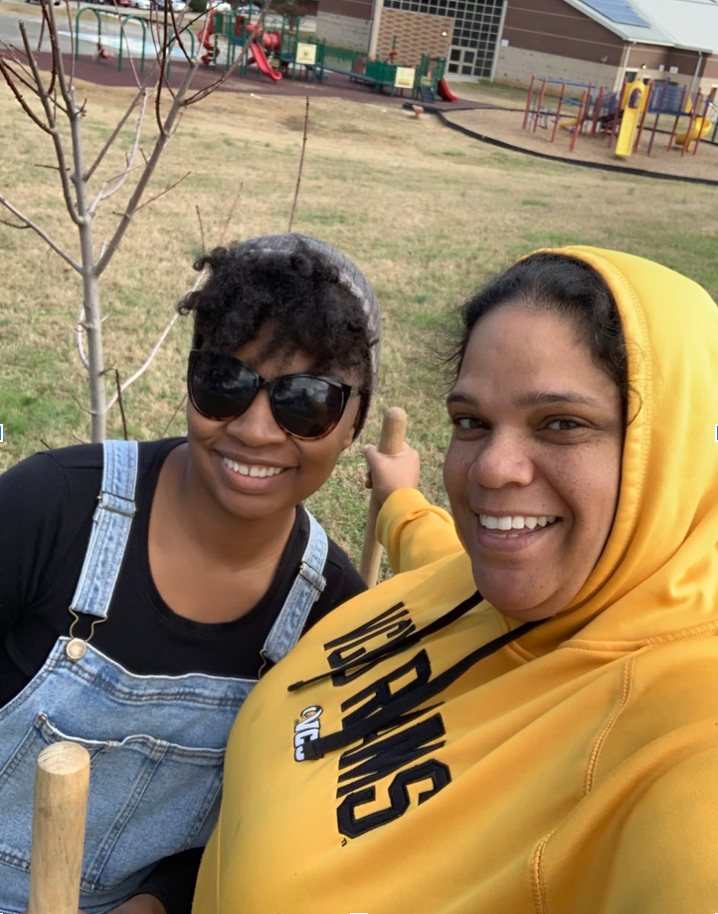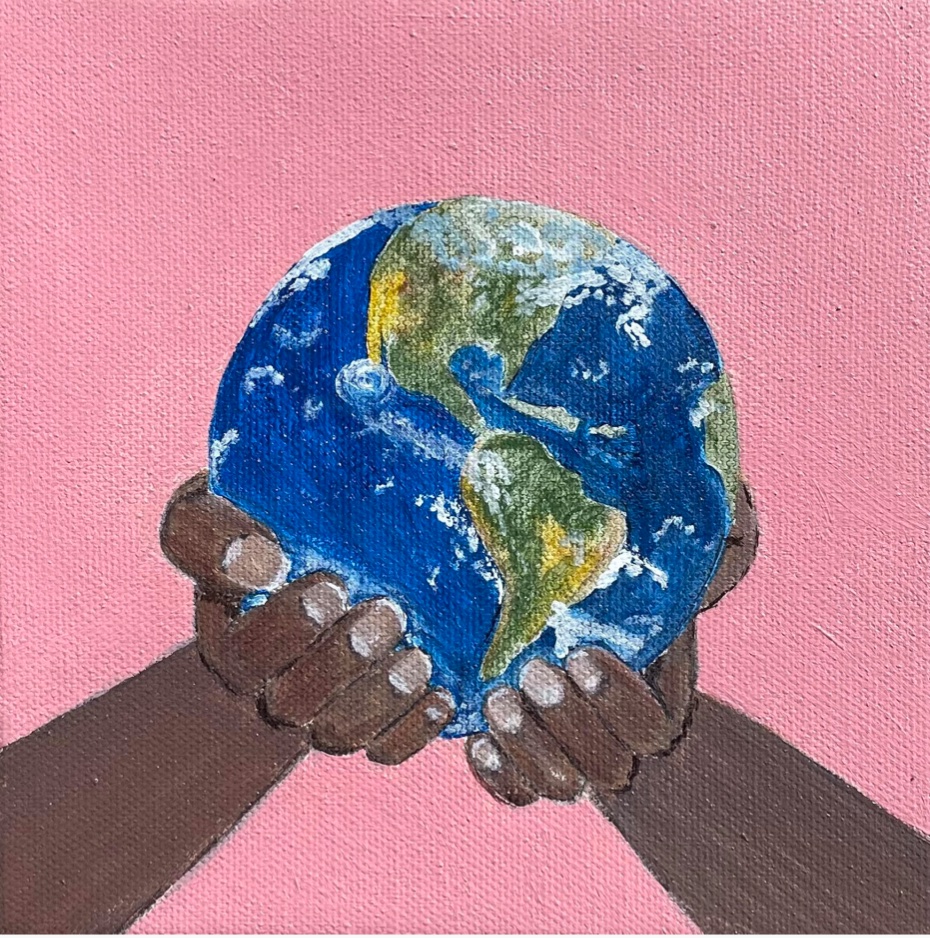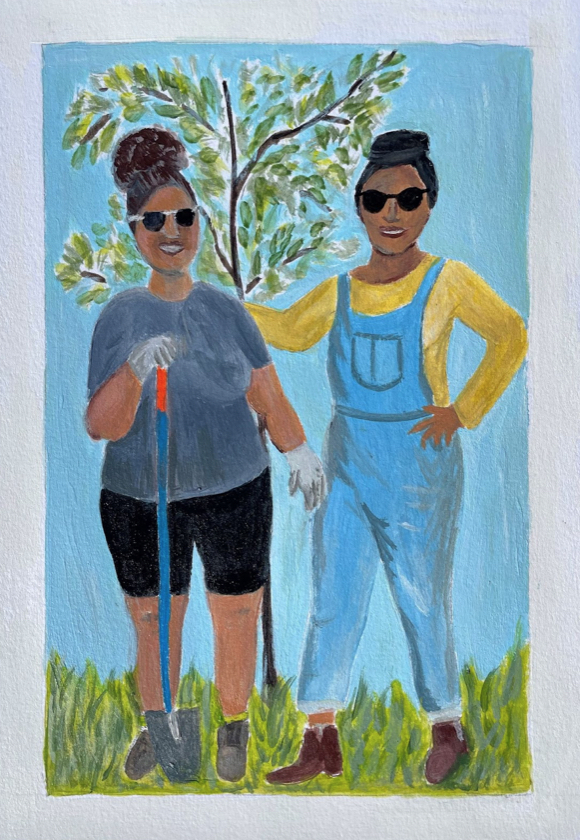By Hallie Tucker
Introdution:
As an intern for the Virginia Water Resources Research Center, I am conducting interviews and creating art about environmental justice leaders, water rights advocates, and scientists, from around the country, to discuss their roles in the fight for environmental justice.
This field, along with the conversations surrounding environmental justice, are becoming increasingly important; and the need for community-led campaigns and policy change is more apparent than ever. When community members begin joining in on the conversation, these movements begin to gain momentum and spark change.
My goal with this campaign is to fuel discussion about the historically disproportionate burden of environmental issues on minority groups by elevating the voices who are already working to change it. It is easy to become overwhelmed with all of the negatives when it comes to the future of our planet and the people on it. I hope that by sharing the great work that is already being done, it will inspire people to take action and become a part of creating a more sustainable future for everyone.

Southside ReLeaf is a 501(c)3 nonprofit community organization that is committed to building a healthy, equitable and sustainable environment for all residents of South Richmond. They are doing this through building green spaces, reducing pollution, increasing community engagement, and advocating for their community to help them adapt to a changing climate.
I was able to sit down with Sheri Shannon who, alongside Amy Wentz, co-founded Southside ReLeaf in 2019.
“For the people not familiar with the term, what is ‘environmental justice’ and why is it important?”
At the heart of environmental justice is policy and the law. What has taken place, the same way with other injustices, whether it’s through the criminal justice system, education, or housing racism. Some systems are set up by decision makers where a community of people are negatively impacted by those decisions. So, the work that we do in the environmental justice space is righting the wrongs, not just through the implementation of projects, but also through policy and advocacy and making sure that there are systems in place to protect those communities so that they are safe, healthy, and are able to thrive.
“How did the environment and sustainability play a role in your life growing up?”
My undergraduate degree is in Earth Sciences from Penn State University. It’s weird, because I started out as a Meteorology major and that was just not my cup of tea. And if you’ve met meteorology people, they are just all about the weather and that was just not my jam. But, I wanted to be in this space. I still wanted to have some type of effect on what was happening in the environmental field. And a lot of that does go back to my upbringing where my grandparents lived in the country on a farm. Acres and acres and acres of land on which they grew everything. So, I did not know that vegetables were sold at the store or came in the can until my grandparents had passed away. Because everything that we ate was grown on the land. So I think about how my grandfather worked those fields, I rode the tractor as a kid, I was shucking corn on the front porch.
My grandmother was one of the first women of color to work for the Department of Forestry. She was a forestry technician. Actually, last year I reached out to the Virginia Department of Forestry and they pulled up her records and they confirmed all of that. At the time, in New Kent, that was the world’s largest single species nursery on the planet. And so my grandma was one of the people responsible for propagation and managing all of those species. At one point my dad was a forestry major.
And like, I have to remind folks that Black people and indigenous folks, Native folks, Latinos; We have a relationship with the land and with our environment. It’s just that in this country, this relationship stems from slavery, and share cropping, and Jim Crow, and genocide. It’s a very negative and bloody history, but if you look at the Black and brown folks in our country, we were the ones and continue to be the people who feed America, who were the original farmers. And a lot of what has been cultivated has been from people who look like me and my family members.

So when looking at that relationship to the land in the history of this country and quite often in the environmental space, it’s very white- very whitewashed. A lot of men as well. So, imagine me, at Penn State, in geology classes. There were very few women and I was usually the only person with melanin sitting in that classroom. I did not look like I belonged. And so, the story of my relationship to environmentalism and how I got to this place started when I was young. That story of resilience, the story of our relationship with land, the way that we view earth; like my grandparents grew produce and they farmed because it was a way to survive -It wasn’t just part of some conservation movement.
So having studied earth sciences at Penn State, I knew I wanted to be in a position to bring both worlds together. Where I could talk about science and I could also be a facilitator and an advocate within the public. So, I worked in American Forests for a decade doing environmental education program management communications. I feel like my journey has made sense along the way. Just from all of the people that have been in my life and the way I interact with the environment, the outdoors. So now with Southside ReLeaf, I think Amy and I are doing a really good job reminding people that the decisions that we make at a local level or at a national level impact the next generation of people, they’re impacting people right now. So, the house that you live in, if you are able to get to a park? If you are able to safely cross the street? If it floods when it rains. If your kid is able to go to a playground that is safe. All of that is impacted by decision makers.So for us, taking all of our personal life experiences and applying all of that into our work and advocacy to make sure that other people are able to have a relationship with green spaces and the outdoors and the environment in their own way without it feeling whitewashed.

“How did you and Amy devise the idea for Southside Releaf?”
Amy and I both started on the Richmond 300 working group and so I was part of the environmental working groups and I believe Amy did economics and housing working groups. Essentially, there was an Insights Report. Within this Insights Report, it gave a breakdown of all of Richmond. The number of people who owned vs rented homes, educational attainment, who had a highschool diploma and who did not. What the median income was, poverty, and health. We kept noticing that all of these gaps, the disparities, were negatively disproportionately impacting people of color specifically in South Richmond.
We got to this one page of the insights report that shows you that Southside residents have a life expectancy that is 20 years shorter than other people in the city. There’s a higher concentration of poverty, higher rates of diabetes and asthma, there are fewer grocery stores, fewer people with highschool diplomas, fewer people who actually are able to own a home. People do not live within a 10 minute walk as far as green spaces. On and on and on.
There are several environmental organizations in the city that are doing incredible work, people that are already on the ground. We felt it was important to solely focus on South Richmond, where we can say, hey, it’s not enough for you to take this approach from an equality standpoint but you need to take this approach from an equity standpoint. The city has to be very intentional about creating policy and investing resources (meaning money and personnel) at the city level to address these inequities. There is no reason that, in the Southside, the playgrounds should be unsafe for children. That is a decision. Someone said that we are not going to invest money for these parks and playgrounds in South Richmond. That is intentional.
Most of these neighborhoods are formally redlined communities. We are already looking at decades of disinvestment. Amy and I said, listen, we know folks are doing this work and that is great, but we can do better. So we came up with Southside ReLeaf. It’s a play on words that I picked up from when I was at American Forest. We thought that was super cute. Here we are, 3 years later, we started the summer of 2019- Our first planting project was the fall of 2019. We are an official 501c(3). It’s great…it’s great.
“If a person were to approach you off the street that doesn’t know about environmental justice, what would you recommend for them to do to tackle environmental disparities?”
It depends on where I am. And I say that, because, If I am talking to someone in the West End [of Richmond], they are going to get it because they have money. They are affluent, they have political capital. These folks are sitting at the top of the privilege, political pyramid.
The conversation I would have with someone in the east end or the 8th or 9th district and Southside might be a little different. I would ask them “why is it so hot out here?” “Well, it’s hot because it’s summertime and we ain’t got no trees. There’s few bus shelters. It’s sweltering. When it rains, it floods, and that is something we hold our breath for every single time there is a major thunderstorm because of the amounts of impervious surfaces we have down there.” Sidewalks, mobility, transit, we would also talk about that too.
If I were to speak with someone in Southside, I would honestly do more listening than I would explaining and educating. I would want to know what is important to them, what concerns they have. And then at that moment saying, “hey, would you like to change that? Would you like to get involved and volunteer? Would you like to help pick up trash?” Just giving them something to do. Especially things that seem like low-hanging fruit because people care about their neighborhoods. We don’t always give folks credit for that. They want it to look pretty and they want it to be nice and safe. Affording them that opportunity and saying, listen, you are not the only person out here who cares.
Empowering folks and letting them know that they have a voice and providing them with the resources and tools to use their voice, to advocate for that change, is probably the most important thing.

I can come in and tell people “we should do xyz 123” but how much more effective would it be if a community member was like “I would love to have trees on this street or I would love to have a mural on this playground.” Or, “sure I would like to come out and help y’all pull up weeds or something.” It seems so small, but once you get people and put them in a position where they can be their own advocates, then you really start to move and shake and pick up some momentum for change.

“Are there any books, podcasts, documentaries or people that have inspired you in your pursuit of Environmental Justice?”
Many… so many. I am going to put on my professional comms hat and do a little pivot. I will say, what has been helpful and motivational for me is seeing other Black women, seeing other Latinas, Native women, Asian women. I thought it was so impactful that the Water Keepers held the line against the Keystone Pipeline.
I think about the folks who sounded the alarm, and are still out there advocating for clean water in Flint, Michigan and other cities around the country. I am always inspired by young people because of their energy. There is something extremely powerful for me, seeing middle-schoolers and high-schoolers walk out of school in protest. To have that courage and to be fearless in doing that, I think that is incredible.
And I always notice how much has changed in the last 5 years, let alone 20 years, when I started this degree, we were still just talking about global warming. I mean it was climate change, but it was definitely more from a scientific and physiological perspective. But now, climate action and climate justice, in our lexicon. And there are more reporters who are communicating and educating the public about that. I am grateful for all of the newsrooms that actually have invested resources into talking about climate and holding elected officials accountable and trying to shift public discourse around this.
There are so many names and books and podcasts. I am going to leave one podcast, it is called Broken Ground by the Southern Environmental Law Center. Essentially, it looks at all of these southern cities, and the impact on climate and its intersections not just from a disaster standpoint but from housing, transportation, and cities trying to come up with the money to build resilience to all of these changes. I like it because it humanizes everything and I think that what is missing so often from this discourse is the human element, it’s the people.
